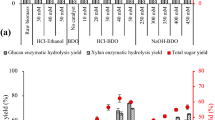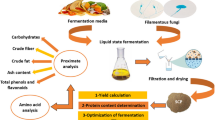Abstract
Paper mill sludge is a solid waste material composed of pulp residues and ash generated from pulping and paper making process. The carbohydrate portion of the sludges from Kraft/Recycle paper mill has chemical and physical characteristics similar to those of commercial wood pulp. Because of its high carbohydrate content and well-dispersed structure, the sludge can be biologically converted to value-added products without pretreatment. In bioconversion of solid feedstock such as paper mill sludge, a certain amount of water must be present to attain fluidity. In this study, hemicellulose pre-hydrolysate, in place of water, was added to the sludge to increase the concentration of the final product. Pre-hydrolysate was obtained by hot-water treatment of pine wood in which the total sugar concentration reached 4 wt.%. The mixture was processed by simultaneous saccharification and fermentation (SSF) using enzymes (cellulase and pectinase) and Lactobacillus rhamnosus (ATCC-10863). Pectinase was added to hydrolyze mannose oligomers in the pre-hydrolysate to monomers. During the SSF of the mixture, calcium carbonate in the paper sludge acted as a buffer, yielding calcium lactate as the final product. External pH control was unnecessary due to the buffer action of calcium carbonate that maintained the pH near optimum for the SSF. The lactic acid yield in the range of 80–90 % of the theoretical maximum was obtained. Use of the mixed feed of pre-hydrolysate and pulp mill sludges in the SSF raised the product concentration to 60 g of lactate/L.





Similar content being viewed by others
References
Xu, G. Q., Chu, J., Wang, Y. H., Zhuang, Y. P., Zhang, S. L., & Peng, H. Q. (2006). Development of a continuous cell-recycle fermentation system for production of lactic acid by Lactobacillus paracasei. Process Biochemistry, 41, 2458–2463.
John, R. P., Nampoothiri, K. M., & Pandey, A. (2007). Fermentative production of lactic acid from biomass: an overview on process developments and future perspectives. Applied Microbiology and Biotechnology, 74, 524–534.
VickRoy, T. B. "Lactic acid, Blanch HW, Drew S, Wang DIC, Comprehensive Biotechnology, 1985, 761–776."
Kharas GB, Sanchez-Riera F, Severson DK. Polymers of lactic acid. In: Mobley DP, editor. Plastics from microbes: microbial synthesis of polymers and polymer precursors. Munich: Hanser, 1994. p. 93–137.
Schmidt, S., & Padukone, N. (1997). Production of lactic acid from wastepaper as a cellulosic feedstock. Journal of Industrial Microbiology and Biotechnology, 18, 10–14.
Rafael Auras, Loong-Tak Lim, Susan E. M. Selke, Hideto Tsuji (ed.). Poly(lactic acid): synthesis, structures, properties, processing, and applications.
Bouchoux, A., Roux-de Balmann, H., & Lutin, F. (2006). Investigation of nanofiltration as a purification step for lactic acid production processes based on conventional and bipolar electrodialysis operations. Separation and Purification Technology, 52, 266–273.
Jim Jem, K., van der Pol, J. F., & de Vos, S. (2010). Microbial lactic acid, its polymer poly(lactic acid), and their industrial applications. Plastics from Bacteria, 14, 323–346.
Hofvendahl, K., & Hahn-Hagerdal, B. (2000). Factors affecting the fermentative lactic acid production from renewable resources. Enzyme and Microbial Technology, 26, 87–107.
Litchfield, J. H. (1996). Advances in Applied Microbiology, 42, 45–95.
Parajo, J. C., Alonso, J. L., & Moldes, A. B. (1997). Production of lactic acid from lignocellulose in a single stage of hydrolysis and fermentation. Food Biotechnology, 11(1), 45–58.
Garde, A., Jonsson, G., Schmidt, A. S., & Ahring, B. K. (2002). Lactic acid production from wheat straw hemicellulose hydrolysate by Lactobacillus pentosus and Lactobacillus brevis. Bioresource Technology, 81(3), 217–223.
Neureiter, M., Danner, H., Madzingaidzo, L., et al. (2004). Lignocellulose feedstocks for the production of lactic acid. Chemical and Biochemical Engineering Quarterly, 18(1), 55–63.
Pope, K.M., Albertson, D.M. Paper sludge—waste disposal problem or energy opportunity, 1999 Engineering Conference Proceedings.
Kang, L., Wang, W., & Lee, Y. Y. (2010). Bioconversion of kraft paper mill sludges to ethanol by SSF and SSCF. Applied Biochemistry and Biotechnology, 161, 53–66.
Lark, N., Xia, Y., Qin, C.-G., Gong, C. S., & Tsao, G. T. (1997). Biomass and Bioenergy, 12, 135.
Biermann, C. J. (1993). Essentials of pulping and papermaking. San Diego: Academic.
Sixta, H. (Ed.). (2006). Handbook of pulp. Wiley-vch.
Yoon, S. H., Macewan, K., & van Heiningen, A. (2008). Hot-water pre-extraction from loblolly pine (Pinus taeda) in an integrated forest products biorefinery. Tappi Journal, 7(436), 27–32.
Yoon, S. H., Cullinan, H. T., & Krishnagopalan, G. A. (2010). Oxidative-reductive modification of alkaline pulping of southern pine integrated with hydrothermal pre-extraction of hemicelluloses. Industrial and Engineering Chemistry Research, 49(13), 5969–5976.
Springer, E. L., & Harris, J. F. (1982). Prehydrolysis of aspen wood with water and with dilute aqueous sulfuric acid. Svensk Papperstidning, 85(3), R152–R154.
Al-dajani, W. W., & Tschirner, U. W. (2008). Pre-extraction of hemicelluloses and subsequent kraft pulping—part I: alkaline extraction. Tappi, 6, 3–8.
NREL, 2008. Laboratory Analytical Procedure (LAP), National Renewable Energy Laboratory, Golden, CO. Available from: http://www.nrel.gov/biomass/analytical_procedures.html
Kang, L., Lee, Y. Y., Yoon, S. H., Smith, A. J., & Krishnagopalan, G. A. (2012). Ethanol production from the mixture of hemicellulose prehydrolysate and paper sludge. Bioresources, 7(3), 3607–3626.
BeMiller, J. N. (1967). Acid-catalyzed hydrolysis of glycosides. Advances in Carbohydrate Chemistry and Biochemistry, 22, 25–108.
Wang, W., Kang, L., Wei, H., Arora, R., & Lee, Y. Y. (2011). Study on the decreased sugar yield in enzymatic hydrolysis of cellulosic substrate at high solid loading. Applied Biochemistry and Biotechnology, 164(7), 1139–1149.
Zhang, Y., Liu, Y. Y., Xu, J. L., Yuan, Z. H., & Zhuang, X. S. (2011). High solid and low enzyme loading based saccharification of agricultural biomass. BioResources, 7(1), 0345–0353.
Cara, C., Moya, M., Ballesteros, I., Negro, M. J., González, A., & Ruiz, E. (2007). Influence of solid loading on enzymatic hydrolysis of steam exploded or liquid hot water pretreated olive tree biomass. Process Biochemistry, 42(6), 1003–1009.
Pessani, N. K., Atiyeh, H. K., Wilkins, M. R., Bellmer, D. D., & Banat, I. M. (2011). Simultaneous saccharification and fermentation of Kanlow switchgrass by thermotolerant Kluyveromyces marxianus IMB3: the effect of enzyme loading, temperature and higher solid loadings. Bioresource Technology, 102(22), 10618–10624.
Rao, R. S., Kumar, C. G., Prakasham, R. S., & Hobbs, P. J. (2008). The Taguchi methodology as a statistical tool for biotechnological applications: a critical appraisal. Biotechnology Journal, 3(4), 510–523.
Taguchi, G. (1987). System of experimental design: engineering methods to optimize quality and minimize costs (Vol. 1). New York: UNIPUB/Kraus International Publications.
Acknowledgments
We gratefully acknowledge the financial support provided by Alabama Center for Paper and Bioresources Engineering and Packaging Corporation of America, Chicago, IL. We also would like to thank Novozymes, North America for providing C-Tec2 enzyme, DuPont-Danisco for providing pectinase enzyme, and Boise Paper Company, Jackson, AL for providing the paper mill sludges.
Author information
Authors and Affiliations
Corresponding author
Rights and permissions
About this article
Cite this article
Shi, S., Kang, L. & Lee, Y.Y. Production of Lactic Acid from the Mixture of Softwood Pre-hydrolysate and Paper Mill Sludge by Simultaneous Saccharification and Fermentation. Appl Biochem Biotechnol 175, 2741–2754 (2015). https://doi.org/10.1007/s12010-014-1451-8
Received:
Accepted:
Published:
Issue Date:
DOI: https://doi.org/10.1007/s12010-014-1451-8




